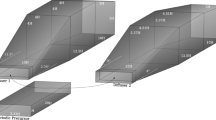Abstract
Modifications of the turbulent separated flow in an asymmetric three-dimensional diffuser due to inlet condition perturbations were investigated using conventional static pressure measurements and velocity data acquired using magnetic resonance velocimetry (MRV). Previous experiments and simulations revealed a strong sensitivity of the diffuser performance to weak secondary flows in the inlet. The present, more detailed experiments were conducted to obtain a better understanding of this sensitivity. Pressure data were acquired in an airflow apparatus at an inlet Reynolds number of 10,000. The diffuser pressure recovery was strongly affected by a pair of longitudinal vortices injected along one wall of the inlet channel using either dielectric barrier discharge plasma actuators or conventional half-delta wing vortex generators. MRV measurements were obtained in a water flow apparatus at matched Reynolds number for two different cases with passive vortex generators. The first case had a pair of counter-rotating longitudinal vortices embedded in the boundary layer near the center of the expanding wall of the diffuser such that the flow on the outsides of the vortices was directed toward the wall. The MRV data showed that the three-dimensional separation bubble initially grew much slower causing a rapid early reduction in the core flow velocity and a consequent reduction of total pressure losses due to turbulent mixing. This produced a 13% increase in the overall pressure recovery. For the second case, the vortices rotated in the opposite sense, and the image vortices pushed them into the corners. This led to a very rapid initial growth of the separation bubble and formation of strong swirl at the diffuser exit. These changes resulted in a 17% reduction in the overall pressure recovery for this case. The results emphasize the extreme sensitivity of 3D separated flows to weak perturbations.













Similar content being viewed by others
References
Abe KI, Ohtsuka T (2010) An investigation of les and hybrid les/rans models for predicting 3-d diffuser flow. Int J Heat Fluid Flow, 31(5):833–844, 2010. Sixth international symposium on turbulence, heat and mass transfer, Rome, Italy, 14–18 September 2009—Turbulence, Heat and Mass Transfer 6
Cherry EM, Elkins CJ, Eaton JK (2008) Geometric sensitivity of three-dimensional separated flows. Int J Heat Fluid Flow 29(3):803–811
Cherry EM, Elkins CJ, Eaton JK (2009) Pressure measurements in a three-dimensional separated diffuser. Int J Heat Fluid Flow 30(1):1–2
Elkins CJ, Markl M, Pelc N, Eaton JK (2003) 4d magnetic resonance velocimetry for mean velocity measurements in complex turbulent flows. Exp Fluids 34:494–503
Elkins CJ, Alley M (2007) Magnetic resonance velocimetry: applications of magnetic resonance imaging in the measurement of fluid motion. Exp Fluids 43:823–858
Gessner FG, Jones JB (1965) On some aspects of fully-developed turbulent flow in rectangular channels. J Fluid Mech 23:689
Grundmann S, Sayles EL, Eaton JK (2010) Sensitivity of an asymmetric 3D diffuser to plasma-actuator induced inlet condition perturbations. Exp Fluids 50(1):217–231
Jakirlić S, Kadavelil G, Kornhaas M, Schäfer M, Sternel DC, Tropea C (2010) Numerical and physical aspects in LES and hybrid LES/RANS of turbulent flow separation in a 3-D diffuser. Int J Heat Fluid Flow 31:820–832
Jakirlić S, Kadavelil G, Sirbubalo E, von Terzi D, Breuer M, Borello D (2010) In: 14th ERCOFTAC SIG15 workshop on turbulence modelling: turbulent flow separation in a 3-D diffuser. ERCOFTAC Bulletin, 82
Klein A (1981) Review—effect of inlet conditions on conical diffuser performance. J Fluid Eng 103:250–269
Launder BE, Reece GJ, Rodi W (1975) Progress in the development of a Reynolds-stress turbulent closure. J Fluid Mech 68(3):537–566
Lin JC (2002) Review of research on low-profile vortexgenerators to control boundary-layer separation. Prog Aerosp Sci 38:389–420
Ohlsson J, Schlatter P, Fischer PF, Henningson DS (2010) Direct numerical simulation of separated flow in a three-dimensional diffuser. J Fluid Mech 650:307–318
Schneider H, von Terzi D, Bauer HJ, Rodi W (2010) Reliable and accurate prediction of three-dimensional separation in asymmetric diffusers using large-eddy simulation. J Fluid Eng 132(3):031101
Song S, Eaton JK (2004) Flow structures of a separating, reattaching, and recovering boundary layer for a large range of Reynolds number. Exp Fluids 36:642–653. doi:10.1007/s00348-003-0762-2
Acknowledgments
We gratefully acknowledge the financial support of several organizations. Sven Grundmann was supported by a fellowship from the DAAD (German Academic Exchange Service) and Emily Sayles was supported by a National Defense Science and Engineering Graduate Fellowship and a Stanford Graduate Fellowship. Research expenses were supported by Siemens Power Generation.
Author information
Authors and Affiliations
Corresponding author
Rights and permissions
About this article
Cite this article
Grundmann, S., Sayles, E.L., Elkins, C.J. et al. Sensitivity of an asymmetric 3D diffuser to vortex-generator induced inlet condition perturbations. Exp Fluids 52, 11–21 (2012). https://doi.org/10.1007/s00348-011-1205-0
Received:
Revised:
Accepted:
Published:
Issue Date:
DOI: https://doi.org/10.1007/s00348-011-1205-0




